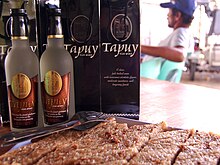
Back Tapé BAN Tapai Spanish Tapai French तपाई Hindi Tapai ID Tapai (gastronomia) Italian タパイ Japanese Tapé JV Tapai Malay Peuyeum Sundanese
 Packaged tapai paste made from cassava in Indonesia | |
| Alternative names | Peuyeum, etc. |
|---|---|
| Type | Rice wine, alcoholic paste |
| Region or state | Southeast Asia, East Asia, South Asia |
| Main ingredients | Usually white rice, glutinous rice |


Tapai (also tapay or tape) is a traditional fermented preparation of rice or other starchy foods, and is found throughout much of Southeast Asia, especially in Austronesian cultures, and parts of East Asia. It refers to both the alcoholic paste and the alcoholic beverage derived from it. It has a sweet or sour taste[1] and can be eaten as is, as ingredients for traditional recipes, or fermented further to make rice wine (which in some cultures is also called tapai). Tapai is traditionally made with white rice or glutinous rice, but can also be made from a variety of carbohydrate sources, including cassava and potatoes.[1][2] Fermentation is performed by a variety of moulds including Aspergillus oryzae, Rhizopus oryzae, Amylomyces rouxii or Mucor species, and yeasts including Saccharomyces cerevisiae, and Saccharomycopsis fibuliger, Endomycopsis burtonii and others, along with bacteria.[1][2]
- ^ a b c Norman F. Haard; et al. (1999). "Fermented Cereals. A Global Perspective". United Nations FAO.
- ^ a b Indrawati Gandjar (August 2003). "TAPAI from Cassava and Cereals" (PDF). University of Indonesia. Archived from the original (PDF) on 26 January 2005. Retrieved 28 July 2006.
© MMXXIII Rich X Search. We shall prevail. All rights reserved. Rich X Search